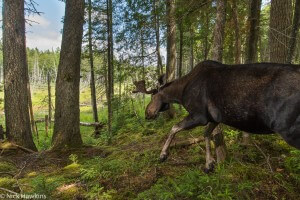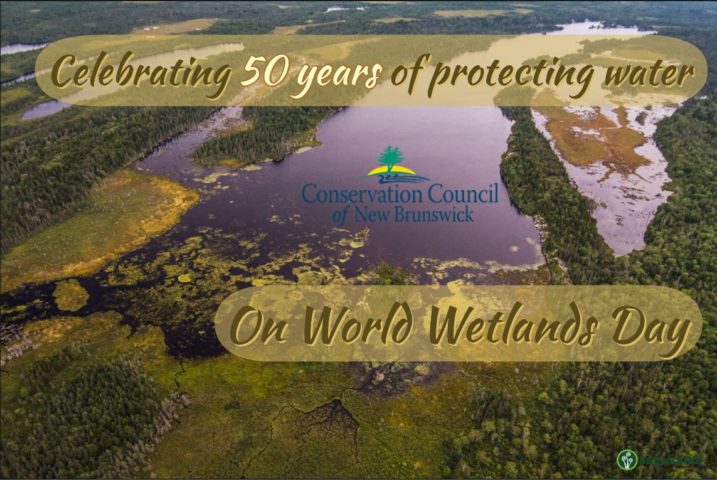
Tomorrow is World Wetlands Day (Feb. 2 ), and this year, it’s a particularly special milestone for us at the Conservation Council.
Why? Two reasons.
- This year — 2019 — marks your Conservation Council’s 50th anniversary as New Brunswick’s leading voice for environmental protection and sustainable communities. And it was concern about water pollution — affecting our rivers, lakes, oceans and wetlands — that led a small group of independent scientists to form the Conservation Council back in 1969 (before, if you can believe it, there was even something called a Department of Environment in New Brunswick).
- This year’s theme is ‘Wetlands and Climate Change’ — and while efforts on water protection led to our formation, efforts to curb the impacts of climate change and shift to a renewable economy has been the overarching focus of the Conservation Council for much of the past few decades.
Before we get into our work on wetland protection and why they are evermore important in today’s changing climate, let’s start by painting a picture of wetlands in New Brunswick.
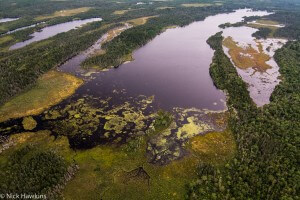
From the salt marshes that dot our 5,000 kilometres of coastline, to the magnificent Tantramar Marshes and the floodplains of rivers like the Wolastoq (St. John) and Miramichi, there is a wide variety of wetlands, bogs, fens and swamps in New Brunswick (take a virtual tour of some of them here!).
While terms like bog and swamp get a bad rep, wetlands are beautiful spaces that are full of life and provide critical ecosystem services to wildlife and people (and our towns, villages and cities) alike.
Wetland ecosystems act as the earth’s kidneys and lungs. They are able to retain water, helping to reduce and mitigate the impacts of flooding and drought, protecting valuable infrastructure and reducing costs associated with property damage. Wetlands also store and absorb carbon while stabilizing our coastlines — pretty important stuff in a time of rising sea levels and escalating carbon pollution.
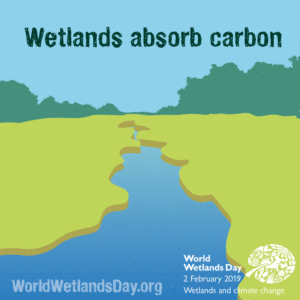
What a long, strange trip it’s been
The problem is, as far as official maps from our provincial government are concerned, half of the wetlands in New Brunswick don’t even exist.
That’s because of the long and frustrating saga of inaction and delayed action on meaningful wetland protection in N.B. We wrote a detailed timeline of this saga for Wetlands Day in 2016, but here’s the gist of it:
- In 2012 the provincial government announced a short term wetland management strategy, including a new wetlands map the government uses to identify wetlands for Environmental Impact Assessments and permitting approvals. The problem: we, and water groups across the province, determined that this new map only showed about half the wetlands that actually exist in N.B., and the whole “management strategy” read more like a “how to guide” for filling in and paving over wetlands for commercial, industrial or residential development.
- A multi-stakeholder group — including your Conservation Council, other conservation groups, industry, municipalities, real-estate associations and more — was formed in 2013 to help develop a long term wetlands strategy. Three years passed and, despite a lot of hard work from environmental organizations, department staff and other stakeholders, no action came on wetland protection.
- To this day, N.B. operates under the flawed short term management strategy introduced in 2012, meaning wetlands are not protected in law.
We need water champions
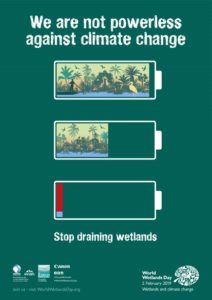 A glimmer of hope surfaced over the last couple of years, when the provincial government’s new, proposed Water Protection Strategy (which your Conservation Council participated heavily as a stakeholder in its development) included a good plan to improve wetland protections between 2018-2020. The strategy would protect wetlands by:
A glimmer of hope surfaced over the last couple of years, when the provincial government’s new, proposed Water Protection Strategy (which your Conservation Council participated heavily as a stakeholder in its development) included a good plan to improve wetland protections between 2018-2020. The strategy would protect wetlands by:
- releasing accurate maps to properly identify our many wetlands,
- creating guidelines to ensure transparency in the province’s Wetlands Conservation Policy, and,
- (the one we’re most excited about) making amendments to the Watercourse and Wetland Alteration Regulation so it protects coastal Provincially Significant Wetlands less than 1 hectare in size.
Fortunately, the new minority government and recently-minted Minister of the Environment and Local Government, the Hon. Jeff Carr, says he will be looking closely at the new water protection strategy, recognizing the multi-stakeholder collaboration that steered its development. Water protection needs a champion at cabinet and we’re confident Minister Carr will see that our wetlands, rivers, lakes, bays and drinking water deserve top shelf protections in law, and that he will see the strategy through!
After all, we know that wetlands are so critical for the health of New Brunswick’s forests, our coastlines, and our marine waters. Functioning wetlands are vital for our communities and the economy to thrive. We need them to keep us safe during times of flooding and keep our natural ecosystem buzzing year round. Filling in or developing wetlands is increasingly putting our water and properties at risk — it’s time to give wetlands the protections they deserve!
